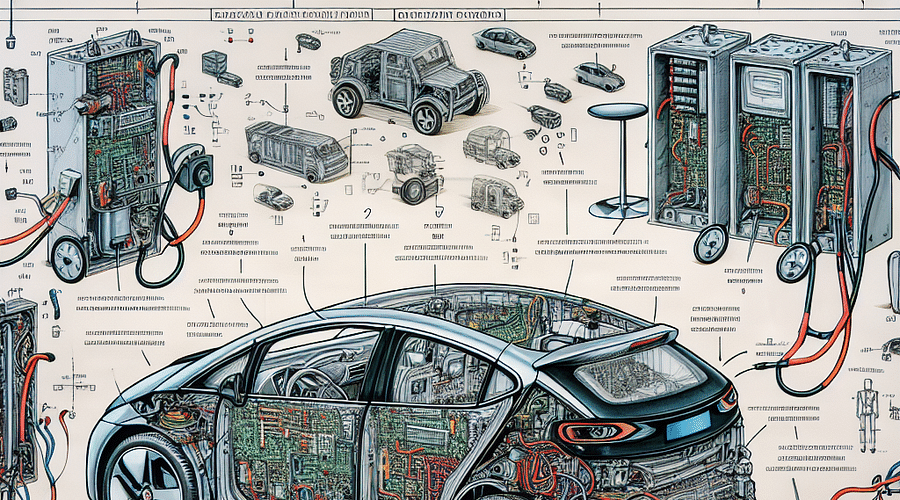Exclusive Insights: How to Fix the Complex Electrical Systems in Electric Cars

For instance, issues such as diminished range or failure to charge can often be traced back to individual cell malfunctions or problems with the battery management system (BMS). A thorough diagnostic routine is essential before attempting any repairs. It's not just about replacing parts; it's about understanding how each component interacts within this electric ecosystem.










Moreover, troubleshooting wiring issues demands a solid grasp of electrical principles and schematics. A methodical approach coupled with advanced diagnostic tools helps isolate faults effectively. Remember that precision is key; overlooking even minor details can lead to system failures or safety risks.
Staying updated with firmware revisions is critical since manufacturers often release patches that fix known bugs. Using proprietary diagnostic software can also provide valuable insights into system health, though third-party OBD-II scanners have come a long way in offering compatibility with EVs.
An understanding of how ECUs are programmed and calibrated is vital when addressing malfunctions. Sometimes, all it takes is a reset or reflash to restore order, but other times you might need to delve deeper into circuit testing or signal analysis.
In conclusion—well, not really a conclusion since we're only halfway through our journey—repairing complex electrical systems in electric cars requires diligence, technical know-how, and an ever-learning mindset. As we continue navigating through this electrified maze, remember that each component plays a crucial role in your vehicle's overall health. Stay tuned for more insights as we delve further into specific repair scenarios and provide you with actionable advice on keeping your electric chariot running like a dream. [quiz: Test your knowledge on repairing complex electrical systems in EVs] Incorporate knowledge from our resources like Electric Car Repair 101, What Every Tesla Owner Should Know, or even take a stab at Tesla Operation Quizzes. For those looking into advanced driver assistance systems (ADAS) tailored for EVs, check out DriverPals' piece on ADAS for Electric Vehicles. And if you're new to Tesla ownership or considering joining the club, don't miss out on guides like Unlock Your Tesla Adventure.The battery management system (BMS) is the brain behind your electric vehicle's power source. It ensures that the battery operates within safe parameters and optimizes its performance and longevity. A malfunctioning BMS can result in reduced range, slower charging times, or even complete failure to operate. To troubleshoot BMS issues, it's crucial to have a comprehensive understanding of its components and their functions. An essential tool for this is a wiring diagram specific to your vehicle's make and model.
Should you encounter errors in the BMS, it may be necessary to reset the system or update its firmware. This process can vary widely between different manufacturers, so referring to your vehicle’s service manual or contacting a certified EV technician is recommended. For those interested in learning more about their Tesla's features, including the BMS, this quiz can test your knowledge and help you become more familiar with your car’s electrical systems.
The electric drive unit (EDU) is another component that often perplexes owners when issues arise. Comprised of an electric motor, power electronics, and transmission, diagnosing problems within this system requires a methodical approach. Starting with visual inspections for any obvious damage or wear can save time before delving into more complex diagnostics involving multimeters and scanning tools.
If you're experiencing reduced performance or strange noises from your EDU, it's possible there could be an issue with the motor bearings or cooling system. In such cases, consulting with professionals who specialize in electric car repair is advisable due to the high voltages involved.
Advanced Driver Assistance Systems are becoming increasingly common in electric vehicles, offering features like autopilot and collision avoidance. However, these systems can be sensitive to faults within the car’s electrical system. When ADAS components start malfunctioning, they not only compromise safety but also contribute to an array of error messages that can be baffling.
To stay informed about ADAS technology specifically designed for electric vehicles and how it integrates with other vehicle systems, resources like DriverPals.com offer valuable insights.
Maintaining a healthy electrical system not only ensures your safety but also preserves the value of your vehicle. If you’re new to driving a Tesla or another EV brand, familiarizing yourself with basic operations through guides like Unlock Your Tesla Adventure: A Beginner’s Guide can help prevent mishaps related to electrical systems.
In summary, fixing complex electrical systems in electric cars demands a blend of knowledge about specific vehicle models and general principles of automotive electronics. Whether it’s understanding how to maintain the BMS or tackling issues with ADAS components, having access to accurate information and reliable diagnostic tools is key. As EV technology advances further into our daily lives, staying up-to-date through quizzes like Tesla Model 3 Power Enhancement Quiz, will ensure you're equipped to handle these sophisticated systems confidently.
Remember: Regular maintenance checks are vital for preventing major repairs down the line. With proper care and attention to detail when addressing electrical issues as they arise, you'll keep your electric car running smoothly for years to come.
Electric vehicles (EVs) are becoming increasingly popular, but their complex electrical systems can present a challenge for repair. Test your knowledge on fixing complex EV electrical systems with this quiz.
Post a comment